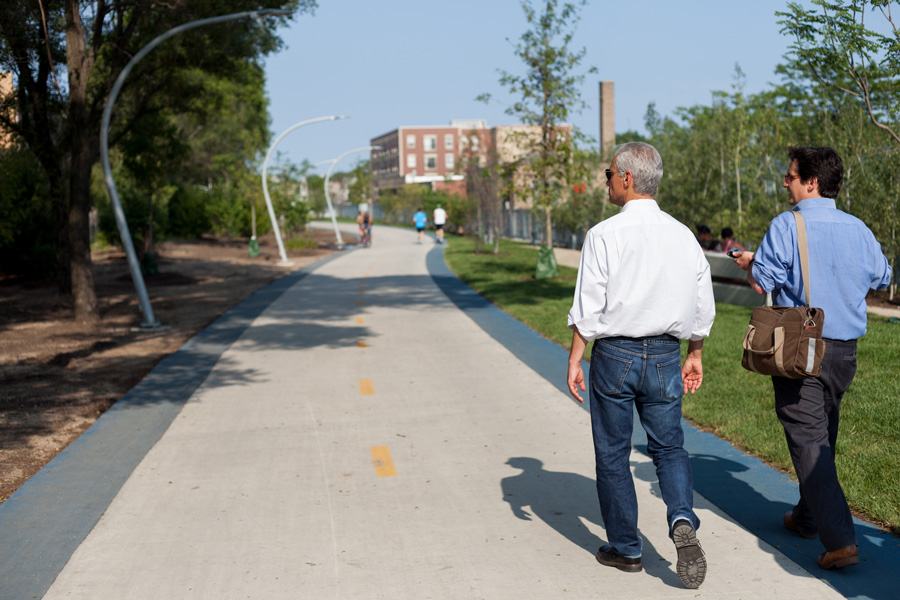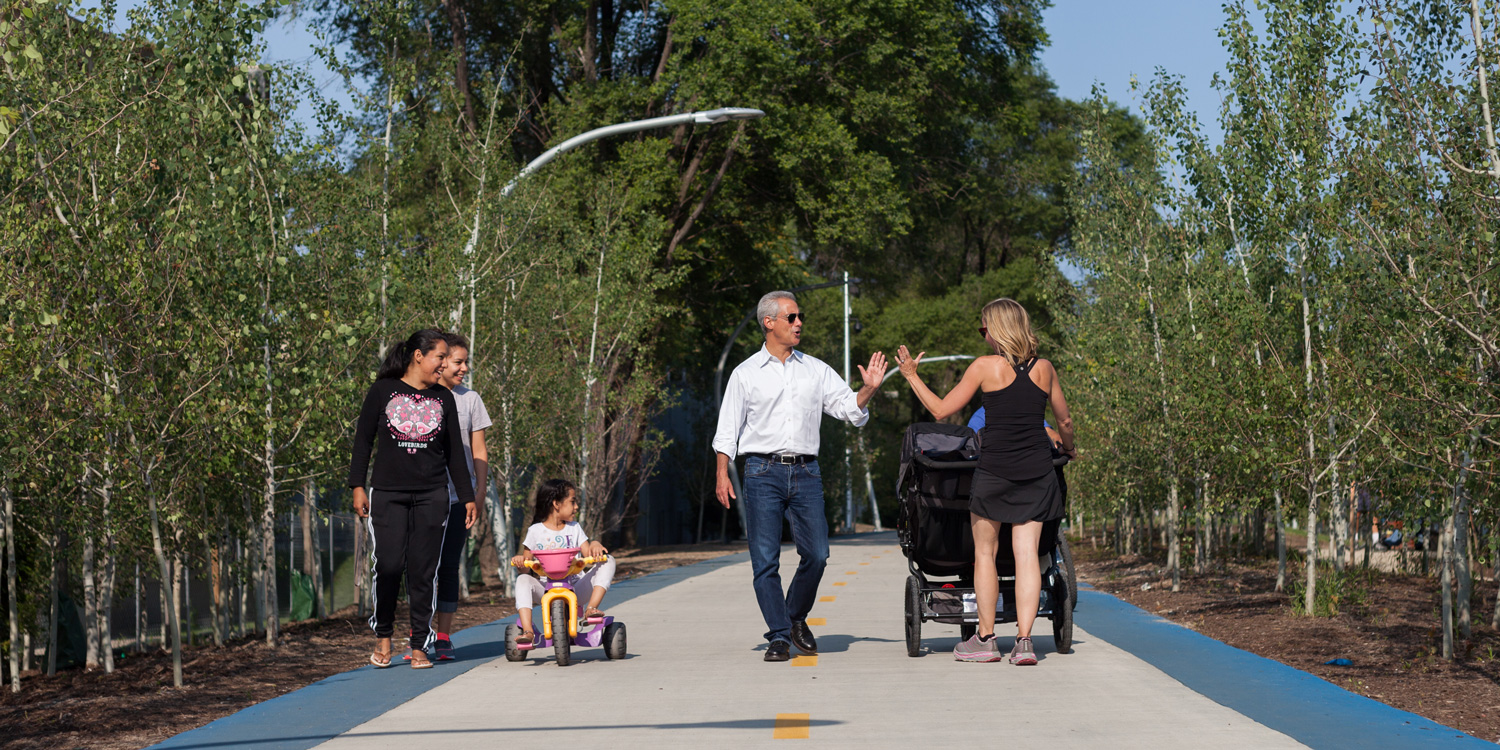Photos: Hallie Dusenberg
Chicago is near the end of what will, I think, be considered a significant period in the history of urban parks. It started with Millennium Park, the urbane, ambitious, expensive downtown sculpture park-cum-garden that put an exclamation point on Richard M. Daley's mayorality. There's Northerly Island, which began its evolution into a park in one of the most famous examples of mayoral fiat. Around the same time, a grassroots effort began that would, 12 years later, become the 606, the city’s new park on the northwest side.
Advertisement
It's a sunny Friday afternoon. The mayor and I are walking the 606—walking, and stopping about every three minutes so the mayor could glad-hand the various runners and walkers passing by (and, in an odd moment, high-five one mom).
One thing he trumpets a lot about the trail is the diversity. The 606 stretches across four Chicago neighborhoods—Wicker Park, Bucktown, Humboldt Park, and Logan Square. "I don't have anything against the High Line [in New York], obviously, but [the 606] brings neighborhoods together and neighbors together who didn't know they were neighbors," he says. "The High Line runs through a business district. There's no doubt it's had a tremendous impact on economics there, [but] for us, this has had a tremendous impact on four distinct neighborhoods of different backgrounds.
"People have been talking about this for years. I told them when I ran for office in 2011, I said I'm going to be for it. No more bake sales, man. Nobody had ever used CMAQ money [a federal grant] for this type of effort. That's what was unique here."
CMAQ money comes from the Department of Transportation—it stands for Congestion Mitigation and Air Quality Improvement—and it's not the only time the city has secured funds to pay for public parks.
The Riverwalk, the new public space that piece-by-piece is opening up along the Chicago River downtown, also comes thanks to federal funding. It dates to a meeting Rahm Emanuel had with transportation secretary Ray LaHood in 2012—and a little-known federal fund that Emanuel had worked on while he was at the White House working for Bill Clinton.
"I said, Ray, I helped create the TIFIA loan, and I knew it had not been used. The two cities that use it the most are L.A. and Chicago," Emanuel says, referring to the 1998 Transportation Infrastructure and Finance and Innovation Act. "We have almost 60 percent of the projects [under it]. I said, 'I want all your staff [together] so we can put everything on the table, and you can tell us what we can do.'"
At that meeting Emanuel was pushing the Department of Transportation for the city to get more funds, so beforehand he needed ideas to pitch on what those funds could be used for. Thus the idea for the Riverwalk was born: in a taxi to LaHood's office with other city officials. (The CTA's Forrest Claypool—tapped last week to be the new CEO for CPS—was seeking funding for the 95th Street Red Line station. Aviation commissioner Rosie Andolino was asking for a centralized car-rental facility at O'Hare.)
Not surprisingly, Emanuel takes most of the credit for the Riverwalk idea—though he shared some of that glory with Andolino.
"Rosie pipes up in the cab and says, 'You know, you've talked in the campaign'—this is 2012, I ran in 2011—'you always talk about the river as the next recreational frontier,'" he says. "Literally, we're in the cab. Rosie says, 'Why don't you do the Riverwalk?' Years ago there were ideas about doing a Riverwalk, but there were no drawings, nothing. That became the way we presented the Riverwalk. It was on the cab ride over to the Department of Transportation."
The Riverwalk is not the only piece of riverine park built towards the mayor's planned rethinking of the river itself. Just as the 606 turned an industrial corridor into an active-transportation corridor, the city is in the process of opening four boathouses—an idea that dates back to the beginning of the mayor's administration. Two of them will be on the North Branch, in North Center and Ravenswood, and two on the South Branch, at Ping Tom Park in Chinatown and in Bridgeport at the site of the long-infamous "Bubbly Creek," which got its name from the horrors dumped into it from the old stockyards.
Advertisement
"They're for canoeing, kayaking, sculling, which you know are all dramatically up," Emanuel says. (I hadn't known that, actually, but it turns out kayaking actually is up, at least nationally. And in Illinois, "human powered craft registration" is up while "motorized small craft registration" is down. The more you know.)
"We never had this," he says. "I never grew up with this. The river was something you walked over, ran over, spit on, or threw something in."
The Riverwalk and the 606 are mirrored on the far South Side by the planned bike park at Big Marsh, another old industrial landscape—this one an industrial waste dump along Lake Calumet—envisioned as an active-leisure and transportation corridor. But about one-sixth of the funding is supposed to come from the state, and state park grants have been put on hold by the governor, which threatens to delay the completion of the 606 as well. "I'm a little ticked at the state right now because they committed money and then they pulled it back," Emanuel says.
Perhaps the state of the city’s parks seems less pressing an issue than, say, the state of the city’s schools—Chicago Public Schools isn't even truly funded through the upcoming school year, and considerable layoffs have already been announced—but parkland is a critical piece of the urban puzzle. One thing I’ve learned living in a small apartment without even a scrap of grass is that parks make urban density possible. As parents of a two-year-old who wants to go to the park every night, my wife and I couldn’t have stayed in our apartment without access to a park. We’re now house-hunting, and proximity to a park has been one of our most important criteria.
And not all neighborhoods have equal access to parks. Three different investigations by three different media outlets—the Tribune, WBEZ, and the Chicago Reporter—all focused on park droughts on the Southwest side of the city. That's also where the city is growing, as a shift in ports-of-call for new Latino immigrants has added population and population density.
"That's why we've opened up the big park in Little Village. I was just there yesterday. That was the biggest desert as it related to open space, and we did the largest brown field conversion in America," Emanuel says. "I'm not saying we're done. Don't get me wrong. It's not like there's not park engagement. When you think of density and you think of population, that's why we're redoing the stand-alone pocket playgrounds throughout, 325 of them… That is where, again, I have a pocket playground on my block. That's how I met the neighbors. I go over there with the kids Saturday morning, help Amy sleep a little late, and I meet our neighbors with our kids just at the swing."
Advertisement
In 2013, city officials boasted that 90 percent of Chicago's children live within a half-mile of a park, or about a ten-minute walk, the Trust for Public Land's standard for reasonable access. That aligns with the TPL's 2013 statistics for the city's entire population, putting the city in the top ten but still leaving almost 250,000 people more than a ten-minute walk from a park. Emanuel says that by 2018, the city will meet the TPL's standard for all the children in Chicago.
Later this year, the department of cultural affairs and special events is hosting a conference to review where the city stands. Tied in with the Chicago Architectural Biennial, the architects behind the 606, the Riverwalk, Maggie Daley Park, and the renovation of Navy Pier will discuss their work (as well as the challenges associated with them) and what's next. Which is….well, anyone's guess.
When I spoke with Beth White, the director of the nonprofit Trust for Public Land, she pointed out Goose Island as a potential project. There's also the 28-acre Finkl Steel site in Lincoln Park, though the mayor says that's more of an issue with the planning department.

When I ask the mayor where the city should focus next, he brings up the South Side marsh as well as a nature preserve at Rosehill Cemetery, which he secured funding for as a congressman way back in 2003 and is only now being built.
And after that?
"I have to finish what I started. Everybody's got another plan for what's next for me, [but] I have to finish the next three [parks]," Emanuel says. "I've got to start the work on the boat house. Everybody else can talk about [the future] and they should. I'm saying they've got to start talking now, because when that's done we have to see what we're going to do."



